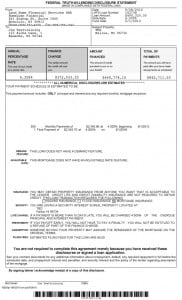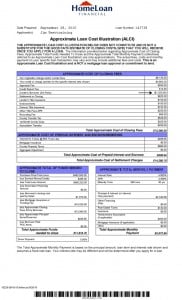 The mortgage industry is regulated by many different federal agencies and has to follow myriad different regulations, some of which overlap, which is fun for everyone (sigh)! We?ll highlight the documents that address the 3 biggest concerns for most homebuyers:
The mortgage industry is regulated by many different federal agencies and has to follow myriad different regulations, some of which overlap, which is fun for everyone (sigh)! We?ll highlight the documents that address the 3 biggest concerns for most homebuyers:
- How much money do I need to pay right now?
- How much am I going to pay every month?
- Can my payment change in the future?
Regulations
Just for fun, here?s a list of regulations that apply to the mortgage process. Each of these require at least one disclosure & some may require even more than one:
- HMDA (Home Mortgage Disclosure Act)
- RESPA (Real Estate Settlement Procedures Act)
- TILA (REG. Z – Truth in Lending Act)
- FACTA (Fair and Accurate Credit Transactions Act)
- ECOA (Equal Credit Opportunity Act)
- Patriot Act
- Financial Privacy Act
- FCRA (Fair Credit Reporting Act)
- Other State Specific Laws
- Other Investor or Guarantor Rules
Three Most Important Disclosures for Borrowers
Out of all those disclosures, there are three that are of most interest to homebuyers & often cause the most confusion. ?Here?s what?s important to look for on each and the strengths and weaknesses of each disclosure:
 GFE – Good Faith Estimate disclosure of fees
GFE – Good Faith Estimate disclosure of fees
- Strengths & Purpose
- Clearly discloses the terms of of your loan on page 1
- The fees disclosed on the form set the limits for what can be charged at closing
- Weaknesses
- It doesn?t show lender, seller or other credits, therefore cash to close can not be determined from this disclosure
- The lender is not bound to the disclosed rate and points until loan is ?locked?, so the rate initially disclosed may not be available at the time of lock.
- The total monthly housing payment is not disclosed, only the principal & interest payment.
 TIL – Truth In Lending disclosure
TIL – Truth In Lending disclosure
- Strengths & Purpose
- Discloses the APR (Annual Percentage Rate), which takes allows you to compare the long term costs of different rate & point combinations by converting them into one number.
- The form sets the maximum APR that you can pay, but it can be re-disclosed later in the process, at which point you have the option to proceed or not.
- Weaknesses
- The APR is not a ?real world figure? and is different from the interest rate you will actually be charged.
- Only some of loan costs are included in APR, so you can?t determine how much cash you will need to close.
- The APR of actual loans differs from those advertised in newspaper
- APR is calculated based on the maximum term of the loan – true costs/breakevens will differ if you plan to keep loan for a shorter period
 Other Disclosure – ALCI (Approximate Loan Cost Illustration)
Other Disclosure – ALCI (Approximate Loan Cost Illustration)
This form is not required by any regulation, but most lenders have a similar form that displays these two critical pieces of information:
- How much cash you will need at closing (or how much cash back you will be receiving)
- Your total monthly housing payment (including condo fees, taxes and insurance)
- Strengths & Purpose of the form
- Shows the expected cash to close number inclusive of all costs and credits
- Shows the total monthly housing payment including Taxes, Insurance and/or Condo Fees
- Weaknesses
- Since the form is not required by any regulation, the terms disclosed are not legally binding.
- Since it is not required, it may differ from lender to lender, or may not even be provided.
Summary
- GFE – good for defining the terms of loan and showing all the fees that can be charged
- TIL – the APR can be used to compare apples to apples as far as one number to look at and evaluate long term loan cost
- ALCI – shows total cash to close & total monthly payment
I hope this summary has given you a little insight about what to look for when signing the documents contained in your loan application package

